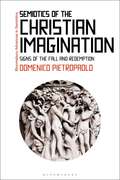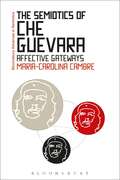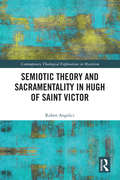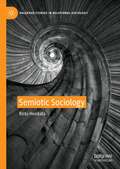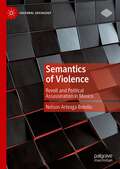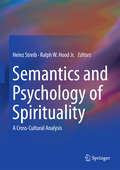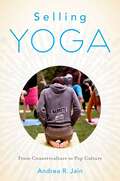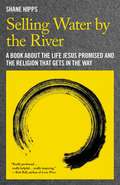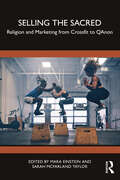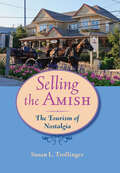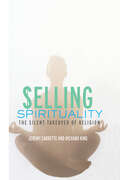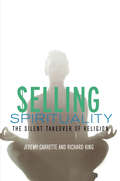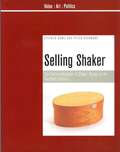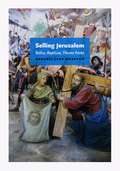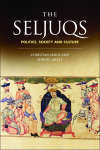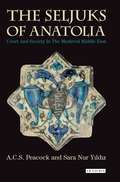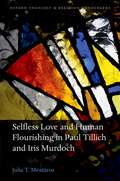- Table View
- List View
Semiotics of the Christian Imagination: Signs of the Fall and Redemption (Bloomsbury Advances in Semiotics)
by Domenico PietropaoloThe semiotics of the Christian imagination describes the repository of signs and the logic of signification through which a community of faith envisions spiritual truths. This book analyses various examples in text, images, music, art and scientific treatise of the imaginative semiotisation of the fall of Man and the Church's semiotic perception of the Divine plan for Redemption.The book includes a chapter detailing the theory of signs, based on a close reading of primary sources, and has nine further chapters on the meaning-making inherent in ideas of the Fall and Redemption of mankind. These are filtered through and given material representation by the semiotic paradigms of various cultural fields, including philology, verbal arts and science.Central to this practice - and to the book's message - are two themes of theological semiotics fundamental to man's understanding of himself in the larger scheme of things. Two of these include the theology of the Fall and a sacramental theory of signs. The theory is grounded in the doctrine of analogy, and this is the only reliable cognitive link between the immanence of the thinking subject and the transcendence that is the object of thought.
The Semiotics of Che Guevara: Affective Gateways (Bloomsbury Advances in Semiotics)
by Maria-Carolina CambreAlberto Korda's famous photograph of Che Guevara titled the "Guerrillero Heroico" has been reproduced, modified and remixed countless times since it was taken on March 5, 1960, in Havana, Cuba.This book looks again at this well-known mass-produced image to explore how an image can take on cultural force in diverse parts of the globe and legitimate varying positions and mass action in unexpected global political contexts.Analytically, the book develops a comparative analysis of how images become attached to a range of meanings that are absolutely inseparable from their contexts of use. Addressing the need for a fluid and responsive approach to the study of visual meaning-making, this book relies on multiple methodologies such as semiotics, research-creation, multimodal discourse analysis, ethnography and phenomenology and shows how each method has something to offer toward the understanding of the social and cultural work of images in our globally oriented cultures.
The Semiotics of Che Guevara: Affective Gateways (Bloomsbury Advances in Semiotics)
by Maria-Carolina CambreAlberto Korda's famous photograph of Che Guevara titled the "Guerrillero Heroico" has been reproduced, modified and remixed countless times since it was taken on March 5, 1960, in Havana, Cuba.This book looks again at this well-known mass-produced image to explore how an image can take on cultural force in diverse parts of the globe and legitimate varying positions and mass action in unexpected global political contexts.Analytically, the book develops a comparative analysis of how images become attached to a range of meanings that are absolutely inseparable from their contexts of use. Addressing the need for a fluid and responsive approach to the study of visual meaning-making, this book relies on multiple methodologies such as semiotics, research-creation, multimodal discourse analysis, ethnography and phenomenology and shows how each method has something to offer toward the understanding of the social and cultural work of images in our globally oriented cultures.
Semiotic Theory and Sacramentality in Hugh of Saint Victor (Contemporary Theological Explorations in Mysticism)
by Ruben AngeliciThis book offers Hugh of Saint Victor’s early scholastic thoughts on sacrament in order to re-discover the pre-modern theological understanding of ontological signification. The Christian understanding of sacrament through the category of ‘signs’ results in a theology that inherently shares in the philosophical notion of semiotics. Yet, through the advent of post-structuralism, current sign-theory is effectively shaped by post-Kantian, ontological foundations. This can lead to misinterpretations of the sacramental theology that predates this intellectual turn. The book works within a context of Christological, realist mysticism. Such an approach allows mutually informing debates in semiotic development and studies on sacramental theology to sit side-by-side. In addition, as a work of ressourcement, influenced by the methodology and concerns of the historical, French Ressourcement, this study seeks to continue an engagement with some of the most promising sacramental positions that have emerged throughout twentieth-century theology, particularly with the revival of interest in Victorine theology. By providing an examination of sacramentality and theories of signification in the early scholastic theology of Hugh of Saint Victor, this book gives fresh impetus to the theology surrounding sacrament. As such, it will be of great interest to scholars of mysticism, theologians of sacrament, philosophical theologians, and philosophers of religion.
Semiotic Theory and Sacramentality in Hugh of Saint Victor (Contemporary Theological Explorations in Mysticism)
by Ruben AngeliciThis book offers Hugh of Saint Victor’s early scholastic thoughts on sacrament in order to re-discover the pre-modern theological understanding of ontological signification. The Christian understanding of sacrament through the category of ‘signs’ results in a theology that inherently shares in the philosophical notion of semiotics. Yet, through the advent of post-structuralism, current sign-theory is effectively shaped by post-Kantian, ontological foundations. This can lead to misinterpretations of the sacramental theology that predates this intellectual turn. The book works within a context of Christological, realist mysticism. Such an approach allows mutually informing debates in semiotic development and studies on sacramental theology to sit side-by-side. In addition, as a work of ressourcement, influenced by the methodology and concerns of the historical, French Ressourcement, this study seeks to continue an engagement with some of the most promising sacramental positions that have emerged throughout twentieth-century theology, particularly with the revival of interest in Victorine theology. By providing an examination of sacramentality and theories of signification in the early scholastic theology of Hugh of Saint Victor, this book gives fresh impetus to the theology surrounding sacrament. As such, it will be of great interest to scholars of mysticism, theologians of sacrament, philosophical theologians, and philosophers of religion.
Semiotic Sociology (Palgrave Studies in Relational Sociology)
by Risto HeiskalaSemiotic Sociology provides solid ground for cultural analysis in the social sciences by building up a mediation between structuralist semiology (Saussure), pragmatist semiotics (Peirce), and phenomenological sociology (Schutz, Garfinkel, Berger and Luckmann). This is a deviation from the common view that these traditions are seen as mutually exclusive alternatives and thus competitors of each other. The net result of the synthesis is that a new social theory emerges wherein action theories (Weber and rational choice) are based on phenomenological sociology and phenomenological sociology is based on neostructuralist semiotics, which is a synthesis of the Saussurean and the Peircean traditions of understanding habits of interpretation and interaction. The core issues of social research are then addressed on these grounds. The topics covered include the economy/society relationship, power, gender, modernity, institutionalization, the canon of current social theory including micro/macro and agency/structure relations, and the grounds of social criticism.
Semantics of Violence: Revolt and Political Assassination in Mexico (Cultural Sociology)
by Nelson Arteaga BotelloThis book describes three impactful cases of political violence that broke out in Mexico in 1994, pointing to an important juncture in Mexican political development. At that point, the patrimonial order centered on the PRI and the Mexican presidency entered a momentous crisis that is still ongoing after a quarter of a century and caused the patrimonial order and the civil order to compete over Mexican public life. Such competition, in turn, unfolds at the cultural level on the terrain of three semantics of political violence that shape public debates over violence in Mexico. Ultimately, this book sheds light over the refraction of patrimonial and civil attributions across such cultural terrains.
Semantics and Psychology of Spirituality: A Cross-Cultural Analysis
by Heinz Streib Ralph W. Hood Jr.This book examines what people mean when they say they are “spiritual”. It looks at the semantics of “spirituality”, the visibility of reasons for “spiritual” preference in biographies, in psychological dispositions, in cultural differences between Germany and the US, and in gender differences. It also examines the kind of biographical consequences that are associated with “spirituality”. The book reports the results of an online-questionnaire filled out by 773 respondents in Germany and 1113 in the US, personal interviews with a selected group of more than 100 persons, and an experiment. Based on the data collected, it reports results that are relevant for a number of scientific and practical disciplines. It makes a contribution to the semantics of everyday religious language and to the cross-cultural study of religion and to many related fields as well, because “spirituality” is evaluated in relation to personality, mysticism, well-being, religious styles, generativity, attachment, biography and atheism. The book draws attention to the – new and ever changing – ways in which people give names to their ultimate concern and symbolize their experiences of transcendence.
Selling Yoga: From Counterculture to Pop Culture
by Andrea JainPremodern and early modern yoga comprise techniques with a wide range of aims, from turning inward in quest of the true self, to turning outward for divine union, to channeling bodily energy in pursuit of sexual pleasure. Early modern yoga also encompassed countercultural beliefs and practices. In contrast, today, modern yoga aims at the enhancement of the mind-body complex but does so according to contemporary dominant metaphysical, health, and fitness paradigms. Consequently, yoga is now a part of popular culture. In Selling Yoga, Andrea R. Jain explores the popularization of yoga in the context of late-twentieth-century consumer culture. She departs from conventional approaches by undermining essentialist definitions of yoga as well as assumptions that yoga underwent a linear trajectory of increasing popularization. While some studies trivialize popularized yoga systems by reducing them to the mere commodification or corruption of what is perceived as an otherwise fixed, authentic system, Jain suggests that this dichotomy oversimplifies the history of yoga as well as its meanings for contemporary practitioners. By discussing a wide array of modern yoga types, from Iyengar Yoga to Bikram Yoga, Jain argues that popularized yoga cannot be dismissed--that it has a variety of religious meanings and functions. Yoga brands destabilize the basic utility of yoga commodities and assign to them new meanings that represent the fulfillment of self-developmental needs often deemed sacred in contemporary consumer culture.
Selling Yoga: From Counterculture to Pop Culture
by Andrea JainPremodern and early modern yoga comprise techniques with a wide range of aims, from turning inward in quest of the true self, to turning outward for divine union, to channeling bodily energy in pursuit of sexual pleasure. Early modern yoga also encompassed countercultural beliefs and practices. In contrast, today, modern yoga aims at the enhancement of the mind-body complex but does so according to contemporary dominant metaphysical, health, and fitness paradigms. Consequently, yoga is now a part of popular culture. In Selling Yoga, Andrea R. Jain explores the popularization of yoga in the context of late-twentieth-century consumer culture. She departs from conventional approaches by undermining essentialist definitions of yoga as well as assumptions that yoga underwent a linear trajectory of increasing popularization. While some studies trivialize popularized yoga systems by reducing them to the mere commodification or corruption of what is perceived as an otherwise fixed, authentic system, Jain suggests that this dichotomy oversimplifies the history of yoga as well as its meanings for contemporary practitioners. By discussing a wide array of modern yoga types, from Iyengar Yoga to Bikram Yoga, Jain argues that popularized yoga cannot be dismissed--that it has a variety of religious meanings and functions. Yoga brands destabilize the basic utility of yoga commodities and assign to them new meanings that represent the fulfillment of self-developmental needs often deemed sacred in contemporary consumer culture.
Selling Water by the River: A Book about the Life Jesus Promised and the Religion That Gets in the Way
by Shane HippsWork, sex, ice cream, religion-they all promise fulfillment. But what they deliver is fleeting.Jesus knew about this quest. He came to show us that peace is possible in this life, not just the next one. Yet Christianity, the very religion that claims Jesus as its own, has often built the biggest barriers to him and the life he promised. Celebrated speaker and pastor Shane Hipps revives the faith with a fresh and persuasive understanding of the message of Jesus. The shocking truth is that Jesus proclaimed "eternal life" as a present reality that dwells within each of us. A transformative breakthrough, this book goes beyond "religion" or "spirituality" and cuts to the heart of our humanity and existence. It's about realizing that we already possess what we are searching for, and that the Heaven we long for isn't just a gift when we die, but a gift while we live.
Selling the Sacred: Religion and Marketing from Crossfit to QAnon
by Mara Einstein Sarah McFarland TaylorThere’s religion in my marketing! There’s marketing in my religion! Selling the Sacred explores the religio-cultural and media implications of a two-sided phenomenon: marketing religion as a product and marketing products as religion. What do various forms of religion/marketing collaboration look like in the twenty-first century, and what does this tell us about American culture and society?Social and technological changes rapidly and continuously reframe religious and marketing landscapes. Crossfit is a “cult.” Televangelists use psychographics and data marketing. QAnon is a religion and big business. These are some of the examples highlighted in this collection, which engages themes related to capitalist narratives, issues related to gender and race, and the intersection of religion, politics, and marketing, among other key issues.The innovative contributors examine the phenomenon of selling the sacred, providing a better understanding of how marketing tactics, married with religious content, influence our thinking and everyday lives. These scholars bring to light how political, economic, and ideological agendas infuse the construction and presentation of the “sacred,” via more traditional religious institutions or consumer-product marketing. By examining religion and marketing broadly, this book offers engaging tools to recognize and unpack what gets sold as “sacred,” what’s at stake, and the consequences.A go-to resource for those working in marketing studies, religious studies, and media studies, Selling the Sacred is also a must-read for religious and marketing professionals.
Selling the Sacred: Religion and Marketing from Crossfit to QAnon
by Mara Einstein Sarah McFarland TaylorThere’s religion in my marketing! There’s marketing in my religion! Selling the Sacred explores the religio-cultural and media implications of a two-sided phenomenon: marketing religion as a product and marketing products as religion. What do various forms of religion/marketing collaboration look like in the twenty-first century, and what does this tell us about American culture and society?Social and technological changes rapidly and continuously reframe religious and marketing landscapes. Crossfit is a “cult.” Televangelists use psychographics and data marketing. QAnon is a religion and big business. These are some of the examples highlighted in this collection, which engages themes related to capitalist narratives, issues related to gender and race, and the intersection of religion, politics, and marketing, among other key issues.The innovative contributors examine the phenomenon of selling the sacred, providing a better understanding of how marketing tactics, married with religious content, influence our thinking and everyday lives. These scholars bring to light how political, economic, and ideological agendas infuse the construction and presentation of the “sacred,” via more traditional religious institutions or consumer-product marketing. By examining religion and marketing broadly, this book offers engaging tools to recognize and unpack what gets sold as “sacred,” what’s at stake, and the consequences.A go-to resource for those working in marketing studies, religious studies, and media studies, Selling the Sacred is also a must-read for religious and marketing professionals.
Selling the Amish: The Tourism of Nostalgia (Young Center Books in Anabaptist and Pietist Studies)
by Susan L. TrollingerMore than 19 million tourists flock to Amish Country each year, drawn by the opportunity to glimpse "a better time" and the quaint beauty of picturesque farmland and handcrafted quilts. What they may find, however, are elaborately themed town centers, outlet malls, or even a water park. Susan L. Trollinger explores this puzzling incongruity, showing that Amish tourism is anything but plain and simple.Selling the Amish takes readers on a virtual tour of three such tourist destinations in Ohio’s Amish Country, the world’s largest Amish settlement. Trollinger examines the visual rhetoric of these uniquely themed places—their architecture, interior decor, even their merchandise and souvenirs—and explains how these features create a setting and a story that brings tourists back year after year.This compelling story is, Trollinger argues, in part legitimized by the Amish themselves. To Americans faced with anxieties about modern life, being near the Amish way of life is comforting. The Amish seem to have escaped the rush of contemporary life, the confusion of gender relations, and the loss of ethnic heritage. While the Amish way supports the idealized experience of these tourist destinations, it also raises powerful questions. Tourists may want a life uncomplicated by technology, but would they be willing to drive around in horse-drawn buggies in order to achieve it?Trollinger's answers to important questions in her fascinating study of Amish Country tourism are sure to challenge readers’ understanding of this surprising cultural phenomenon.
Selling the Amish: The Tourism of Nostalgia (Young Center Books in Anabaptist and Pietist Studies)
by Susan L. TrollingerMore than 19 million tourists flock to Amish Country each year, drawn by the opportunity to glimpse "a better time" and the quaint beauty of picturesque farmland and handcrafted quilts. What they may find, however, are elaborately themed town centers, outlet malls, or even a water park. Susan L. Trollinger explores this puzzling incongruity, showing that Amish tourism is anything but plain and simple.Selling the Amish takes readers on a virtual tour of three such tourist destinations in Ohio’s Amish Country, the world’s largest Amish settlement. Trollinger examines the visual rhetoric of these uniquely themed places—their architecture, interior decor, even their merchandise and souvenirs—and explains how these features create a setting and a story that brings tourists back year after year.This compelling story is, Trollinger argues, in part legitimized by the Amish themselves. To Americans faced with anxieties about modern life, being near the Amish way of life is comforting. The Amish seem to have escaped the rush of contemporary life, the confusion of gender relations, and the loss of ethnic heritage. While the Amish way supports the idealized experience of these tourist destinations, it also raises powerful questions. Tourists may want a life uncomplicated by technology, but would they be willing to drive around in horse-drawn buggies in order to achieve it?Trollinger's answers to important questions in her fascinating study of Amish Country tourism are sure to challenge readers’ understanding of this surprising cultural phenomenon.
Selling Spirituality: The Silent Takeover of Religion
by Jeremy Carrette Richard KingFrom Feng Shui to holistic medicine, from aromatherapy candles to yoga weekends, spirituality is big business. It promises to soothe away the angst of modern living and to offer an antidote to shallow materialism. Selling Spirituality is a short, sharp, attack on this fallacy. It shows how spirituality has in fact become a powerful commodity in the global marketplace - a cultural addiction that reflects orthodox politics, curbs self-expression and colonizes Eastern beliefs.Exposing how spirituality has today come to embody the privatization of religion in the modern West, Jeremy Carrette and Richard King reveal the people and brands who profit from this corporate hijack, and explore how spirituality can be reclaimed as a means of resistance to capitalism and its deceptions.
Selling Spirituality: The Silent Takeover of Religion
by Jeremy Carrette Richard KingFrom Feng Shui to holistic medicine, from aromatherapy candles to yoga weekends, spirituality is big business. It promises to soothe away the angst of modern living and to offer an antidote to shallow materialism. Selling Spirituality is a short, sharp, attack on this fallacy. It shows how spirituality has in fact become a powerful commodity in the global marketplace - a cultural addiction that reflects orthodox politics, curbs self-expression and colonizes Eastern beliefs.Exposing how spirituality has today come to embody the privatization of religion in the modern West, Jeremy Carrette and Richard King reveal the people and brands who profit from this corporate hijack, and explore how spirituality can be reclaimed as a means of resistance to capitalism and its deceptions.
Selling Shaker: The Promotion of Shaker Design in the Twentieth Century (Value: Art: Politics #1)
by Stephen Bowe Peter RichmondThe Shakers – a religious community whose origins are founded in the eighteenth century – continue to exert an influence upon twenty-first century life, not for their religious teachings but rather through the simple yet elegant aesthetic they developed for the everyday artefacts they designed for themselves. Selling Shaker aims to explore this influence and chart its evolution throughout the course of the twentieth century via the interest shown by the media, art institutions and general public in the Shaker story. Whilst other books have sought to examine the origins of the religious or aesthetic basis of the movement throughout the course of the eighteenth and nineteenth centuries, this book seeks to deal with the Shaker phenomenon from a different angle. Selling Shaker examines the means by which the Shakers have been ‘promoted’ during the course of the last century by scholars and museum academics in order to establish a ‘national’ style. The book follows this process from high art to popular culture influences illustrating how the Shaker style has entered the general design consciousness and in doing so has become a generic style largely divorced from the original Shaker aesthetic. Using a variety of sources ranging from museum catalogues to contemporary design magazines, Selling Shaker aims to tell the story of the rise and rise of the Shaker phenomenon.
Selling Jerusalem: Relics, Replicas, Theme Parks
by Annabel Jane WhartonJerusalem currently stands at the center of a violent controversy that threatens the stability of both the Middle East and the world. This volatility, observes Annabel Jane Wharton, is only the most recent manifestation of a centuries-old obsession with the control of the Holy City—military occupation and pilgrimage being two familiar forms of “ownership.” Wharton makes the innovative argument here that the West has also sought to possess Jerusalem by acquiring its representations. From relics of the True Cross and Templar replicas of the Holy Sepulchre to Franciscan recreations of the Passion to nineteenth-century mass-produced prints and contemporary theme parks, Wharton describes the evolving forms by which the city has been possessed in the West. She also maps those changing embodiments of the Holy City against shifts in the western market. From the gift-and-barter economy of the early Middle Ages to contemporary globalization, both money and the representations of Jerusalem have become progressively incorporeal, abstract, illusionistic, and virtual. Selling Jerusalem offers a penetrating introduction to the explosive combination of piety and capital at work in religious objects and global politics. It is sure to interest students and scholars of art history, economic history, popular culture, religion, and architecture, as well as those who want to better understand Jerusalem’s problematic place in history.
Selling Jerusalem: Relics, Replicas, Theme Parks
by Annabel Jane WhartonJerusalem currently stands at the center of a violent controversy that threatens the stability of both the Middle East and the world. This volatility, observes Annabel Jane Wharton, is only the most recent manifestation of a centuries-old obsession with the control of the Holy City—military occupation and pilgrimage being two familiar forms of “ownership.” Wharton makes the innovative argument here that the West has also sought to possess Jerusalem by acquiring its representations. From relics of the True Cross and Templar replicas of the Holy Sepulchre to Franciscan recreations of the Passion to nineteenth-century mass-produced prints and contemporary theme parks, Wharton describes the evolving forms by which the city has been possessed in the West. She also maps those changing embodiments of the Holy City against shifts in the western market. From the gift-and-barter economy of the early Middle Ages to contemporary globalization, both money and the representations of Jerusalem have become progressively incorporeal, abstract, illusionistic, and virtual. Selling Jerusalem offers a penetrating introduction to the explosive combination of piety and capital at work in religious objects and global politics. It is sure to interest students and scholars of art history, economic history, popular culture, religion, and architecture, as well as those who want to better understand Jerusalem’s problematic place in history.
Selling Jerusalem: Relics, Replicas, Theme Parks
by Annabel Jane WhartonJerusalem currently stands at the center of a violent controversy that threatens the stability of both the Middle East and the world. This volatility, observes Annabel Jane Wharton, is only the most recent manifestation of a centuries-old obsession with the control of the Holy City—military occupation and pilgrimage being two familiar forms of “ownership.” Wharton makes the innovative argument here that the West has also sought to possess Jerusalem by acquiring its representations. From relics of the True Cross and Templar replicas of the Holy Sepulchre to Franciscan recreations of the Passion to nineteenth-century mass-produced prints and contemporary theme parks, Wharton describes the evolving forms by which the city has been possessed in the West. She also maps those changing embodiments of the Holy City against shifts in the western market. From the gift-and-barter economy of the early Middle Ages to contemporary globalization, both money and the representations of Jerusalem have become progressively incorporeal, abstract, illusionistic, and virtual. Selling Jerusalem offers a penetrating introduction to the explosive combination of piety and capital at work in religious objects and global politics. It is sure to interest students and scholars of art history, economic history, popular culture, religion, and architecture, as well as those who want to better understand Jerusalem’s problematic place in history.
The Seljuqs: Politics, Society and Culture
by Christian Lange Songül MecitThis volume seeks to fill the gap in the historiography of premodern Islam and is conceived as a new standard scholarly resource for those interested in the Seljuk period.
The Seljuks of Anatolia: Court and Society in the Medieval Middle East (Library of Middle East History)
by A. C. Peacock Sara Nur Yildiz Dr Sara Yildiz A.C.S. PeacockOne of the most powerful dynasties to rule in the medieval Middle East, the Seljuks played a critical role in the development of Anatolia's multi-ethnic, multi-confessional identity. Under Seljuk rule (c. 1081-1308) the formerly Christian Byzantine territories of Anatolia were transformed by the development of Muslim culture, society and politics, and it was then – well before the arrival of the Ottomans – that a Turkish population became firmly established in these lands. But these developments are little understood, and the Seljuk dynasty remains little studied. Yet the Seljuks of Anatolia were one of the most influential dynasties of the thirteenth-century Middle East, controlling some of the major trade routes of the period, playing a crucial role in linking East and West of the medieval world.Here, Andrew Peacock and Sara Nur Yildiz explore the history of Anatolia under Seljuk rule in the twelfth and thirteenth centuries, examining developments in culture, politics, religion and society and shedding new light on the influence of the dynasty within Anatolia and throughout Western Asia. The Seljuks of Anatolia examines the crucial aspect of the Seljuk dynastic identity, and how this related to their royal households, and to the material and literary arts they sought to influence and promote through patronage. It also demonstrates how the Seljuks played a critical role in the development of Islamic culture in Anatolia, with strong influences from Iran, Syria and further afield. By taking this critical role into account, this book offers an analysis of the religious transformations that occurred during this period, from the Byzantine and Christian identities that prevailed amongst the Seljuks to the Sufis that held key positions in the Seljuk court.With its lively discussion of Seljuk identity, politics and culture, The Seljuks of Anatolia will be of great interest to researchers with interests in Byzantium as well as the material culture and society of the medieval Islamic world.
Selfless Love and Human Flourishing in Paul Tillich and Iris Murdoch (Oxford Theology and Religion Monographs)
by Julia T. MeszarosIn an age of self-affirmation and self-assertion, 'selfless love' can appear as a threat to the lover's personal well-being. This perception jars with the Biblical promise that we gain our life through losing it and therefore calls for a theological response. In conversation with the Protestant theologian Paul Tillich and the atheistic moral philosopher and novelist Iris Murdoch, Selfless Love and Human Flourishing in Paul Tillich and Iris Murdoch enquires into the anthropological grounds on which selfless love can be said to build up, rather than undermine, the lover's self. It proposes that while the implausibility of selfless love was furthered by the modern deconstruction of the self, both Tillich and Murdoch utilize this very deconstruction towards explicating and restoring the link between selfless love and human flourishing. Julia T. Meszaros shows that they use the modern diagnosis of the human being's lack of a stable and independent self as manifest in Sartre's existentialism in support of an understanding of the self as relational and fallen. This leads them to view a loving orientation away from self and a surrender to the other as critical to the full flourishing of human selfhood. In arguing that Tillich and Murdoch defend the link between selfless love and human flourishing through reference to the human being's ontological selflessness, Meszaros closely engages Søren Kierkegaard's earlier attempt to keep selfless love and human flourishing in a productive, dialectical tension. She also examines the breakdown of this tension in the later figures of Anders Nygren, Simone Weil, and Jean-Paul Sartre, and addresses the pitfalls of this breakdown. Her examination concludes by arguing that the link between selfless love and human flourishing would be strengthened by a more resolute endorsement of a personal God, and of the reciprocal nature of selfless love.
Selfless Love and Human Flourishing in Paul Tillich and Iris Murdoch (Oxford Theology and Religion Monographs)
by Julia T. MeszarosIn an age of self-affirmation and self-assertion, 'selfless love' can appear as a threat to the lover's personal well-being. This perception jars with the Biblical promise that we gain our life through losing it and therefore calls for a theological response. In conversation with the Protestant theologian Paul Tillich and the atheistic moral philosopher and novelist Iris Murdoch, Selfless Love and Human Flourishing in Paul Tillich and Iris Murdoch enquires into the anthropological grounds on which selfless love can be said to build up, rather than undermine, the lover's self. It proposes that while the implausibility of selfless love was furthered by the modern deconstruction of the self, both Tillich and Murdoch utilize this very deconstruction towards explicating and restoring the link between selfless love and human flourishing. Julia T. Meszaros shows that they use the modern diagnosis of the human being's lack of a stable and independent self as manifest in Sartre's existentialism in support of an understanding of the self as relational and fallen. This leads them to view a loving orientation away from self and a surrender to the other as critical to the full flourishing of human selfhood. In arguing that Tillich and Murdoch defend the link between selfless love and human flourishing through reference to the human being's ontological selflessness, Meszaros closely engages Søren Kierkegaard's earlier attempt to keep selfless love and human flourishing in a productive, dialectical tension. She also examines the breakdown of this tension in the later figures of Anders Nygren, Simone Weil, and Jean-Paul Sartre, and addresses the pitfalls of this breakdown. Her examination concludes by arguing that the link between selfless love and human flourishing would be strengthened by a more resolute endorsement of a personal God, and of the reciprocal nature of selfless love.
